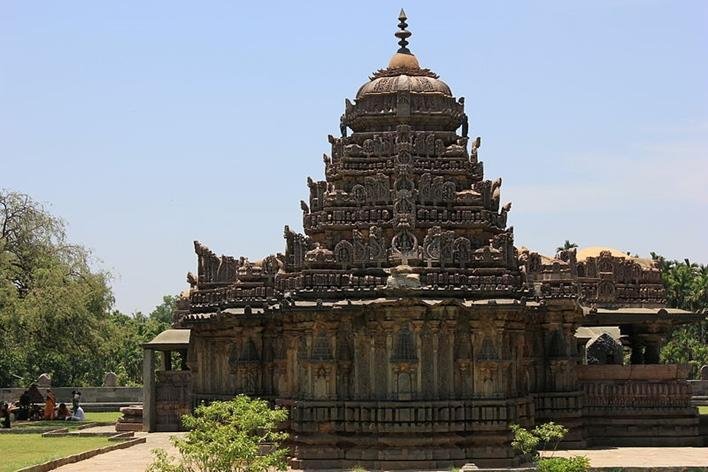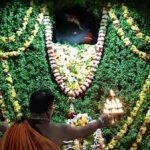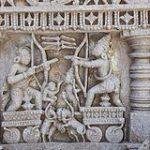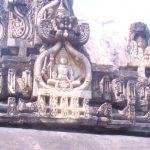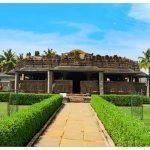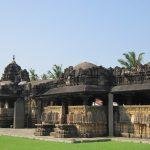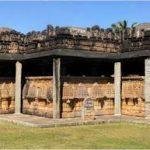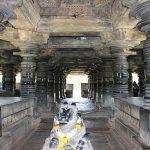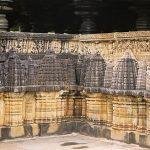Amrutesvara Temple, Amruthapura, Chikkamagaluru, Karnataka
| Date built: | 12th century |
|---|---|
| Deity: | shivalinga |
| Architectural style: | – |
| Major festivals | – |
| Locale: | – |
| District:: | Chikkamagaluru |
| Address: | Amruthapura Village, Near Tarikere, Chikmagalur District – 577228 |
| Phone | – |
The Amruteshvara temple also spelt “Amrutesvara” or “Amruteshwara”, is located in the village of Amruthapura, 67 km north of Chikmagalur town in the Chikkamagaluru district of the Karnataka state, India. Located 110 km from Hassan and 35 km from Shimoga on NH 206, Amruthapura is known for the Amruteshvara temple . The temple was built in 1196 C.E. by Amrutheshwara Dandanayaka (lit, “commander”) under Hoysala King Veera Ballala II.
Architecture
The temple is a built according to Hoysala architecture with a wide open mantapa (hall).The temple has an original outer wall with enique equally spaced circular carvings. The temple has one vimana (shrine and tower) and therefore is a ekakuta design,and has a closed mantapa (hall) that connects the sanctum to the large open mantapa.
It is medium-sized Hoysala temple with certain vastu features similar to the Veera Narayana Temple, Belavadi in mantapa structure and size. The open mantapa has twenty nine bays,[3] and the closed mantapa has nine bays with a side porch that leads to a separate shrine on the south side. The shrine is square in shape has the original superstructure (shikhara) which is adorned with sculptures of Kirtimukhas (demon faces), miniature decorative towers (aedicule). Below the superstructure, the usually seen panel of Hindu deities is absent. The base of the wall has five mouldings which according to art critic Foekema is an “older Hoysala style”.[4] The sukanasi, the tower on top of the vestibule that connects the sanctum to the closed mantapa (the Sukanasi appears like the nose of the superstructure),has the original Hoysala emblem of “Sala” fighting the lion.
The rows of shining lathe turned pillars that support the ceiling of the mantapa is a Hoysala-Chalukya decorative idiom.[8] The mantapa has many deeply domed inner ceiling structures adorned with floral designs. The outer parapet wall of the open mantapa has a total of hundred and forty panel sculptures with depictions from the Hindu epics. Unlike many Hoysala temples where the panels are small and carvings in miniature, these panels are comparatively larger. The Ramayana is sculpted on the south side wall on seventy panels, with the story proceeding quite unusually, in anti-clockwise direction. On the north side wall, all depictions are clockwise, a norm in Hoysala architectural articulation. Twenty five panels depict the life of the Hindu god Krishna and the remaining forty five panels depict scenes from the epic Mahabharata.
Ruvari Mallitamma, the well known sculptor and architect is known to have started his career here working on the domed ceilings in the main mantapa. The large stone inscription near the porch contains poems composed by medieval Kannada poet Janna who had the hororific Kavichakravarti (lit, “emperor among poets”) .
Legend / Local stories
The temple was constructed in the 12th century by the commander Amrutheshwara Dandanayaka, during the rule of Veera Ballala II, the Hoysala King. The rise of the Hoysalas also coincided with the spread of this certain design philosophy which can to this day be seen across the state of Karnataka. One of Karnataka’s most famous sculptors was Mallitamma, and it is believed that he started his artistic career at Amruthapura, suggesting the beginning of a golden architectural age.
The main deity of the temple is Lord Shiva and the shivalinga at the temple is a 300-year-old Trimurti brought from the River Kandikevale in Nepal. The idol of Sharadha Devi sits next to the shiva linga. Some of the important rituals performed at the Amrutesvara temple include Bilva Archane and Kumkuma Archane.
Aksharbhyasam is also another ritual that can be performed at this temple. Devotees visit the temple for many reasons, including concerns related to wealth and diseases. It is also believed that those whose children are suffering in education can come and offer prayers here. Some of the thanksgiving gifts left at the temple include sarees.
Architecture of Amrutesvara Temple
The temple is located in a quiet spot close to the reservoir of the Bhadra River. This 12thcentury structure was built following the many hallmark features of Hoysala architecture. Many experts describe this temple as part of the older Hoysala style of architecture.
The oldest parts of the Amrutesvara Temple are the porch, garbhagriha, sukhanasi and the navaranga, and as time progressed there were more additions and embellishments made. The wide hall or mantapa is one of the important parts of a Hoysala style temple. The mantapa of the Amrutesvara Temple has many impressive pillars, ornate and lathe-turned.
The open and closed mantapas feature many inner-ceiling structures that have detailed floral designs. The square shrine sits below a super structure of shikhara. The shikhara of the Amrutesvara Temple is decorated with intricate carvings of demon faces and mini towers.
On one of the temple towers, one can find the emblem of the Hoysalas, the Sala battling a lion. On the sukhanasi tower, visitors can also find an elaborate panel depicting Shiva slaying Gajasura. The wall reliefs of the temple give visitors a glance at the important Hindu beliefs and stories that defined the spiritual leanings of the Hoysala dynasty.
One of the important pieces of sculptures on the temple can be found on the southern wall, a detailed depiction of events from the Ramayana, the story’s linear timeline represented in an anti-clockwise direction, quite unusual.
The north side has more panels depicting important Hindu mythology. One can find the events of the Mahabharata here depicted this time in a clockwise direction along with panels chronicling the life of Krishna.
A stone inscription in the complex is considered a great example of old Kannada poetry, the work attributed to Janna, one of the most famous poets of the region.
Kirtimukha sculptures on shikhara at Amrutesvara Temple. Image courtesy: Dineshkannambadi
Photo Gallery
How to Reach:
Apart from Chikmagalur, the nearest big towns are Shimoga (35 kilometres away) and Tarikere so these remain important transit points when travelling to Amruthapura.
By Air
The closest airport by distance is in Mangalore, 220 kilometres away. However the route from Bangalore International Airport would take a similar time to cover despite being around 282 kilometres away, due to more open roads in long stretches.
By Rail
The nearest railway station to the temple is located 11 kilometres away in Tarikere. From the railway station it is a short 20 minute journey to the temple via NH206. Trains that ply between Shimoga and the cities of Bangalore and Mysore usually stop at Tarikere.
By Road
From Bangalore city, the best route to reach the temple by road is via the NH79 and SH24, stops which include Tumkur. It is 260 kilometre journey and should take close to 5 hours to complete. One can also catch a direct bus to Shimoga and then find local transport that would take them to the temple.
The Chikmagalur district is one of the most scenic in the beautiful state of Karnataka. Enjoy a visit to the Amrutesvara temple to witness its architectural glory in the backdrop of the serene landscape. Karnataka is a medley of cultures and belief-systems, moulded by a multi-layer history and there are many spiritual and historical sites to explore here, Amrutesvara Temple being on that list.
Contact Details
Official Address

